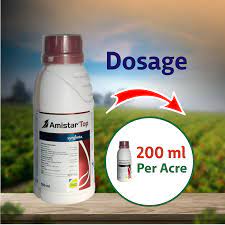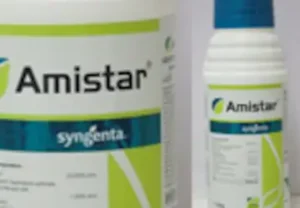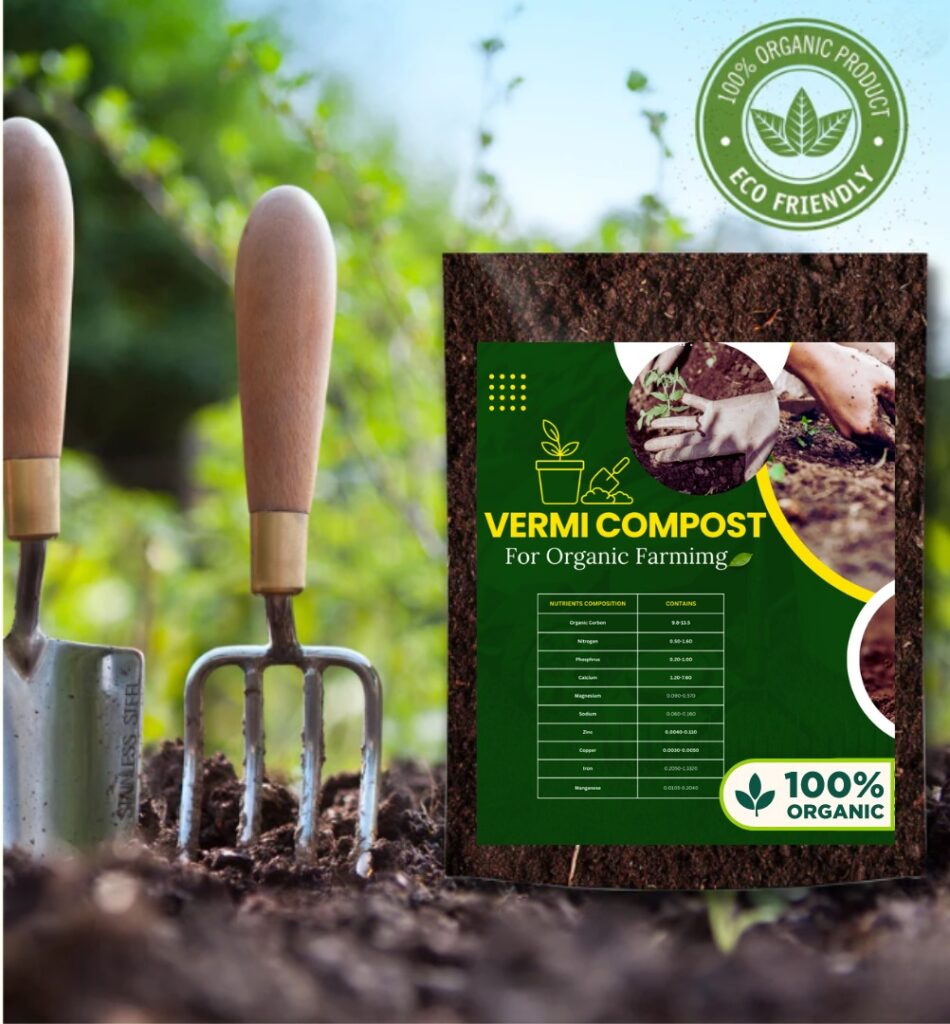In this article you’ll get the complete information about Syngenta Amistar fungicide including the following:
- Introduction
- Translaminar fungicide
- Technical content
- Formulation
- Active ingredients
- Mode of action
- Doses
- Benefits
- Application
- Uses

The Syngenta Amistar fungicide is systemic, which means that it penetrates the plant and spreads throughout the tissue to offer long-lasting defense. Additionally, it is a translaminar fungicide, which enables it to pass through leaves and offer defense on both the top and lower surfaces.
Translaminar fungicide can further be explained as fungicide that can pass through leaves to the surface they contact on the other side, but they are not fully systemic and do not spread throughout the entire plant. Fungicide is redistributed between the top, sprayed leaf surface and the lower, unsprayed leaf surface by translaminar fungicides.
Amistar fungicide Technical content: 23% SC Azoxystrobin
Danger category: Caution
Formulation: Suspension Concentrate (SC) is the formulation
Active Substances present in the Amistar fungicide
- Azoxystrobin: This fungicide is a member of the strobilurin class. It functions by preventing fungus from making energy by blocking their mitochondrial respiration. Azoxystrobin is a wide-spectrum fungicide, making it useful against a variety of various fungal infections.
- Difenoconazole: A fungicide made of triazoles is diffenoconazole. It functions by causing fungal’s cell membranes to rupture, which kills the fungi. In order to better effectively control fungi-related infections, difenoconazole, another broad-spectrum fungicide, is frequently combined with azoxystrobin.
Method of Action
It works by preventing fungus from respiring their mitochondria. This indicates that it hinders fungi from generating energy, which ultimately results in their death. Azoxystrobin and difenoconazole work together to have a synergistic effect, which makes them far more efficient at killing fungi when combined than when used separately. This is due to the fact that the two substances inhibit fungus development in distinct ways.

The dose of Amistar fungicide required according to the disease of the crop:
| Disease | Dosage | Crop |
| Early blight in potatoes | 1-2ML/ lit of water | Potatoes |
| Late blight in tomatoes | 1-2ML/ lit of water | Tomatoes |
| Grey leaf spot in maize | 1-2ML/ lit of water | Maize |
| White blister in crucifers | 1-2ML/ lit of water | Cruciferous vegetables |
| Powdery mildew in cucurbits | 1-2ML/ lit of water | Cucurbit vegetables |
| Anthracnose in dry beans | 1-2ML/ lit of water | Dry beans |
| Powdery mildew in peppers | 1-2ML/ lit of water | Peppers |
| Foliar diseases of onions | 1-2ML/ lit of water | Onions |
Benefits of using Amistar fungicide:
- Broad-spectrum control:
It works well against a variety of fungi, including rust, downy and powdery mildew.
It travels throughout the tissue after being absorbed by the plant and has systemic and translaminar activity, offering long-lasting defense. Additionally, it has the ability to glide among the leaves, offering cover on both the upper and below surfaces.
- Both therapeutic and preventive action:
It can be used to manage current fungi infections and stop the spread of infections.
- Low environmental impact:
The product is reasonably safe and has a small environmental impact.
Bees and other helpful insects are unaffected by amistar fungicide.

Application of Amistar fungicide:
Amistar fungicide should be sprayed on the leaves. The crop and the disease’s severity affect the suggested application rate.
The following three elements are crucial when using a fungicide spray: (1) The quantity of spray solution used in a certain area (for example, a 20-foot row, an acre, or per thousand square feet), (2) The kind of spray nozzle, and (3) The spray pressure. The combinations of all three are changed to provide the ideal spray pattern for the crop and the fungicide being used.
The spray solution needs to get through the plant canopy and reach the lower leaves because many diseases start on the lower leaves of the plant. If good protection is to be gained, especially if a topical fungicide is employed, the solution must also coat the underside of the plant leaves. To optimize the spray, the three crucial variables—spray volume, spray nozzle, and spray pressure—are modified to improve the plant canopy penetration and coating of the plant components.
Why you should choose Amistar fungicide?
- A wide spectrum with the top-selling strobilurins internationally.
- Strobiline, a highly systemic antibiotic that protects the entire crop canopy.
- Recognized for having a favorable impact on crop productivity and quality.
- Aids the plant to more effectively fend off abiotic stress and utilize the nutrients given.
Amistar fungicide uses:
- Increases the flower conserving potential of the plants.
- Effectively eliminates broad spectrum of disease on a wide variety of crop
- Makes the foliage greener and healthier.
FAQs
- How Amistar fungicide works?
Ans. Amistar works on the fungus’s respiratory system to rob it of the energy it needs to expand, thus killing the fungus in the process.
2. What is Amistar fungicide price?
Ans. To know more about Syngenta Amistar fungicide contact us at https://khetkidawai.com/



